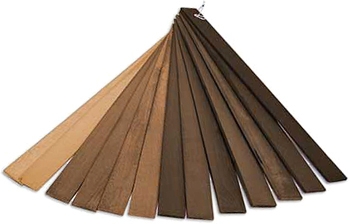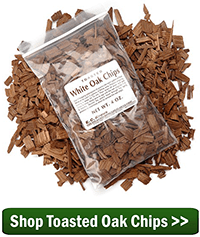 I have tried oaking wine to my satisfaction with oak chips. Now I want to make my own toasted oak strips. I purchased some white oak that I sawed into yard stick width and thickness. I noticed in the wine supplies different types of flavors for oaking. I was told it was like flavored coffee. What should I do to the oak strips so as I can oak wine?
I have tried oaking wine to my satisfaction with oak chips. Now I want to make my own toasted oak strips. I purchased some white oak that I sawed into yard stick width and thickness. I noticed in the wine supplies different types of flavors for oaking. I was told it was like flavored coffee. What should I do to the oak strips so as I can oak wine?
Thanks,
Marvin F.
—–
Hello Marvin,
First, I want to commend you on your DIY spirit. It’s fun hearing about people tryin’ to get it done on their own.
This is a project that is a little more involved than one might first suspect. Toasting oak to be used in wine is a very delicate process. I for one would suggest that you are probably better off by leaving this one to the experts. But I understand your drive to try doing this yourself.
 First, it is important that you use a white oak as opposed to red oak. You seem to be okay in that department based on you question, above. Red oak is a completely different family of wood. The only thing they have in common is the word “oak”.
First, it is important that you use a white oak as opposed to red oak. You seem to be okay in that department based on you question, above. Red oak is a completely different family of wood. The only thing they have in common is the word “oak”.
The oak then needs to be dried to what cooperages refer to as sap clear. They typically do this by letting the slats or staves of wood dry cross-stacked in the sun for 1 to 3 years. The oak strips are rotated and rearranged periodically to allow for even drying. Someone trying this at home could get around this if they happen to have a kiln of some sort to dry the slats out, or maybe they have a source of white oak that has already been sitting around for a few years.
Once the white oak is sap clear it then needs to be toasted. This is typically done over a flame of burning white oak wood. Oak is used for the fire for toasting as opposed to another wood or fuel to keep foreign residues to a minimum. Try not to let the smoke from the fire directly hit the wood. Rely more on the fire’s radiating heat by keeping the wood adjacent to the fire instead of over the fire.
There is some art and some science to toasting oak for wine. Not only do you need to be concerned about how toasted the oak wood is becoming, you also need to be concerned about the temperature being used to do the toasting. Both how much you toast the oak and how fast it toasts plays into the flavor the wood will contribute to the wine.
If the wood is toasted too fast there is not enough time for all the caramelized sugars in the wood to raise to the surface. The heat doesn’t penetrate the wood deep enough. Toast the wood too long and you will raise too much tannin with the sugar which will bring too much bitterness to the wine. The right temperature a length of time is beyond my experience and most cooperages keep this info as a trade secret, but you can get a sense of what to do by seeing how a wine barrel (not whiskey barrel) is toasted.
Because of the complexity involved, I would suggest that you do not try this yourself and purchase some oak that has been professionally prepared. It is not something I would try, especially when an entire batch of wine may be on the line, and the toasted oak is relatively inexpensive.
Happy Wine Making,
Ed Kraus
—–
Ed Kraus is a 3rd generation home brewer/winemaker and has been an owner of E. C. Kraus since 1999. He has been helping individuals make better wine and beer for over 25 years.

I think Marvin should do his reaserch on toasting oak and do it. How else do you become an expert. If I wanted to take the easy route to wine making I would just go to the store and buy a bottle.
Whether Marvin uses store bought toasted oak or toasts his own depends on how much is this a hobby? He’s obviously doing it for the experience. One thing that I found when homebrewing beer is that I never made a beer that I didn’t like. Maybe wouldn’t make again… It’s always fun to taste our mistakes.
I’ve been a cabinet maker for many years and The white oak I purschase has already been kiln dried. So I question your drying time. Unless you have bought it directly from the mill wet. As an experiment I took my BBQ smoker and lowered the temp down to a cold smoke temp. And had some success that way. Good luck to you
Did that done that…Used about 4 home made charred white oak staves, all well dried. The Nero D’Avola became incredibly bitter-sour after just 3 months of bulk aging. The wine has improved since then but I will not try this again unless I learn more about what happend.
can you use white oak that has not been toasted.
Yes, you can use untoasted oak, however the flavor you add to the wine will be quite different. It will be more of a woody character rather than a vanilla or coconut you get from toasted oak.
Can you get an expert to tell us how to roast white oak.White oak in Australia is expensive and not easy to come by.I would to know how much oak you put into 10gal of mead? How long do you leave it for?.I make a good mead, but would like to improve in it.
I agree with Ed. I sold oak wine barrels for 10 years. There has been no shortage of poor oak treatment and p*** poor oak “toasting” ideas that have ruined ten of thousands of gallons of wine in my opinion. You MUST age the oak lest you simply leech all the harsh, sappy components of the oak directly into your wine. Aging is not a short process. Oak is a dense wood that benefits from seasoning. At this point oak alternatives are super cheap (compared to the $1,000+/barrel I sometimes sold them for), so do yourself a favor and benefit from their experience and business model. If not, sure, throw some chips on the Barby and drink some smoky, mediocre plonk.
Having been into making wine myself for the last 10-12 years I still consider myself a beginner and experimenter. With that said I have done some extensive research on the matter of toasting my own wood not to save money but to see what it would be like to toast and try different woods in my wine and beer making. There are some websites that explain how to do this. the keys are the type of wood (hard woods only and the types are few),, the toasting temperature, and the length of toasting time. I just recently did this and have not had the time to experiment yet but will be doing so in the near future. Good luck to any who try.
Joe, you mention that there are some websites that explain how to toast your own oak wood. Could kindly give these addresses? Thanks.
As you can see from the comments there is a little bit of science and technology and a lot of mystery and closely held secrets involved in cutting, drying and toasting oak (or other woods) for wine production.
If you really like a challenge, go ahead and try. good luck.
1- If you are in the US make sure you start with white oak, quercus alba. There are other oaks in the US that are in the white oak group but might yield considerably different results.
2- If you are starting with the tree be aware that everything you cut with a chain saw the sawed surface will have to be removed later with a non-lubricated saw. All subsequent sawing must be done with non-lubricated blades, ie. buzzsaw or sawmill. You will be disappointed if your wine tastes like a Stihl.
3- Kiln drying usually yields 12ish percent moisture. If you are drying your own protect from mice, bugs, etc. and take plenty of time. You will have to buy an inexpensive moisture meter over internet.
4- Keep the wood clean every step of the way. Splitting by hand probably makes the most sense for experimental small amounts.Always split off the bark.
5- Toast in gas or electric oven, I would suggest electric but your choice. Temperature and time, who knows – good luck and have fum
I am interested in making sparkling wine looking for a high end kit. Most kits I see look cheap.
I have been using kiln dried white oak for woodworking many years. I cut slivers then toasted at 250, 350 and 400 in the oven for 2 hours. All give a nice flavor with 350 being most pleasant. 400 good for distillates because you get the added color. White oak just has a nice flavor however at 250, the end product just tastes like wood, no caramelzation. I found no difference between the toasted french oak chips I bought compared to what I made. But the bags of chips are inexpensive so just try it. It is like tea bags in that duration and temp impart more flavor so it makes sense to sample as you go. Just my 2 cent opinion but white oak is good for flavor and woodworking. Red oak is good for woodwrking but terrible for flavor. Sassafras wood is nice but hard to find.